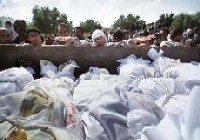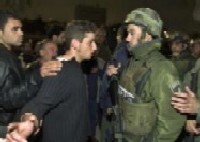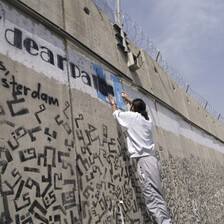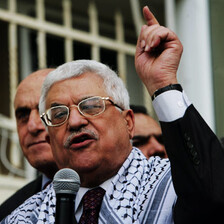
REUTERS/Goran Tomasevic
Looking out of the window of the office, we could see three APCs and two military jeeps driving up the hill. At 3 o’clock in the afternoon the curfew seemed lifted, at least, a colleague, who lives in the same area, stepped in the office.
Even if the military jeep would have passed by my appartment, I probably still would think it would have been the guy selling melons or ka’aak. This was not the first time that we weren’t aware that there had been a curfew imposed on the neighborhood.
As I was skimming through the newspapers, my attention was caught by an article in the National Post. Again, I read another lie from an Israeli spokesperson:
“I think you will find that this was the most fierce of the battles we had, and not only was there no massacre, but the Israeli army did everything to protect civilian lives.”
Rabbi Michael Melchior, Israel’s deputy foreign minister, defended the military’s actions, saying soldiers were rooting out Palestinian “terrorists” who had turned the refugee camp into a fortress and used civilians as shields. This reminds me of Thomas L. Friedman’s description of the aftermath of the Sabra and Shatila massacre in his book From Beirut to Jerusalem:
“The Israeli soldiers did not see innocent civilians being massacred and they did not hear the screams of innocent children going to their graves. What they saw was a ‘terrorist infestation’ being ‘mopped up’ and ‘terrorist nurses’ scurrying about and ‘terrorist teenagers’ trying to defend them, and what they heard were ‘terrorist women’ screaming. In the Israeli psyche you don’t come to the rescue of ‘terrorists.’ There is no such thing as ‘terrorist’ being massacred.”
Rabbi Michael Melchior accused Palestinian “terrorists” of having used “civilians as shields”, while in fact, according to a recent report of Amnesty International, Israeli forces have often used Palestinians effectively as human shields, endangering their lives and in violation of international humanitarian law. Moreover, initial findings of LAW’s investigation in Jenin refugee camp and consistent testimonies of eyewitnesses show that Palestinians has been used as human shields, with soldiers holding them in front of them as they moved from room to room, house to house including through the walls of adjacent homes (by destroying the connecting walls). Some of the human shields had soldiers shooting at Palestinians with the guns propped on their shoulders, whilst hiding behind them.
Moreover, the 2001 Country Report on Human Rights Practices (March 4, 2002) prepared by the Bureau of Democracy, Human Rights, and Labor of the US State Department reported that “Israeli soldiers at times placed Palestinians directly in the line of fire between the soldiers and their targets, or prevented civilians from exiting buildings that were immediately surrounded during armed operations.”
While on April 9, Shimon Peres admitted that “what happened in Jenin was a massacre”, thirteen days later, he denied the charges and told the pro-Israel lobby AIPAC, that 47 fighters and three civilians were killed in the Jenin camp, along with 23 Israeli soldiers. However, eventhough it is not possible to verify the numbers of those killed or injured at this stage, as access to these sites of killings are still largely denied or severely restricted, many are reported missing or believed to be dead or injured so are unaccounted for, and many dead bodies remain in homes, streets, buildings where they were shot, or under the rubble of homes destroyed, and have not been able to be removed. Much higher numbers of dead are anticipated.
As of April 14, there were approximately 747 men and boys in the surrounding villages of Romani, Zbubaa and Taybeh, as having been in Jenin refugee camp after they made their way to these villages when they were released from the Israeli detention center in Salem. Out of these 747, about 500 confirmed that they had family members missing. Additionally, the Israeli army stated that about 400 families, amounting to about 3,000 refugees were staying within the city of Jenin. Moreover, they have stated that about 1,200 from Jenin refugee camp remain in Israeli detention and interrogation centers. Accordingly, based on these initial figures there are more than 8,500-9,500 currently unaccounted for. The ICRC and UNWRA have not been able to properly start the process of tracing these missing people because of the current humanitarian crisis.
On March 5, 2002, Israeli Prime Minister Ariel Sharon, speaking to the press said: “The Palestinians must be hit and it must be very painful. We must cause them losses, victims, so that they feel the heavy price.”
This month, an Israeli think tank, the Jaffee Center for Strategic Studies, released its annual national security public opinion poll conducted among Israeli Jews. Forty-six percent of the respondents favored “transfer” of the entire indigenous Palestinian population from the occupied Palestinian Territories. This figure went above 60 percent when the question was phrased, as in “Should Israel actively encourage the Palestinian Arabs to leave the country?”
“Transfer”, for the uninitiated, is the Israeli-coined term for ethnic cleansing or mass expulsion. So here we have significant indications that a majority of the population of a democratic state may openly support ethnic cleansing. Not only does Israel continue to occupy and repress an entire captive nation with brutal military force, but its people openly discuss, without a hint of irony, how best to commit war crimes. And the international community stands by and watches.
Reading again, Thomas Friedman’s description of the aftermath of the 1982 Sabra and Shatila massacre in his book From Beirut to Jerusalem:
“Many Israelis had so dehumanized the Palestinians in their own minds and had so intimately equated the words ‘Palestinian,’ ‘PLO,’ and ‘terrorists’ on their radio and television for so long, actually referring to ‘terrorist tanks’ and ‘terrorist hospitals,’ that they simply lost track of the distinction between Palestinian fighters and Palestinian civilians, combatants and noncombatants.”

REUTERS/Nir Elias
By midnight, Israeli border police and those who still look like soldiers had sealed off the area, which runs from the junction just meters away from the American Colony and the road passing the YWCA. When we arrived, a group of Palestinian and Israeli protesters and journalists, was standing before a line of soldiers and policeman. Settlers had already moved into the buildings. The families, who’s property deeds went back to the time of Ottoman rule, were standing on the other side of the road, some crying, others angry. Later, extreme-right Tourism Minister, Benny Elon, who has been promoting “transfer” or ethnic cleansing, arrived at the scene. He was greeted with chants of “garbage” and “Nazi” by protesters before being ferried behind the police blockade by border police officers.
Two months ago, Ben Lynfield of the Christian Science Monitor wrote in an article entitled Israeli expulsion idea gains steam on February 6, that Elon’s media blitz for the mass expulsion of Palestinians has gained momentum. Elon has not only pushed the idea of ethnic cleansing in a series of interviews, but his party has also put up billboards in Tel Aviv stating that, “Only transfer will bring peace.” Elon believes that under conditions of war, Israel has the right to bring upon the Palestinians “another nakba,” or catastrophe, similar to 1948, when thousands of Palestinians were expelled. Elon proposed adopting a transfer policy based on the principle of “I will close the universities to you, I will make your lives difficult, until you want to leave.”
Elon heads a group intent on reclaiming Jewish property in the part of Jerusalem where Palestinians live. The group has made several attempts to take over buildings in Sheik Jarrah.
Lousewies van der Laan, told The Jerusalem Post that she was “appalled” at the eviction of the families.



